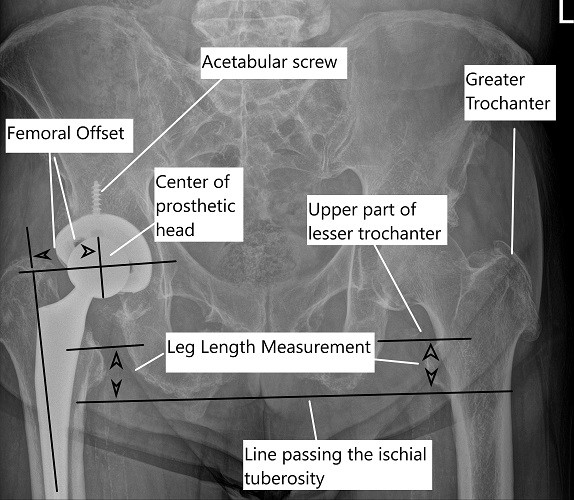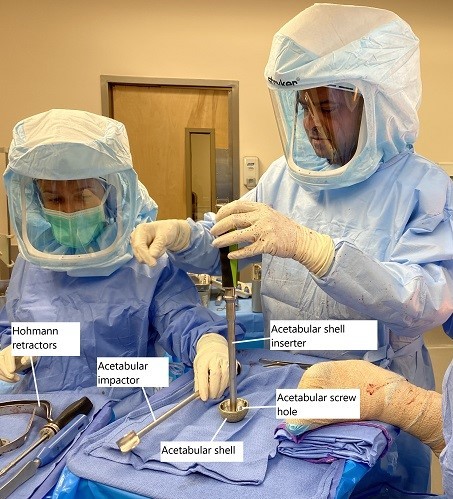Leg Length Discrepancy After Hip Replacement
Leg length discrepancy is the occurrence of uneven leg length after a total hip replacement surgery. The leg length discrepancy is a rare complication and may be a result of an actual leg shortening or lengthening or may simply be functional.
Functional leg length discrepancy occurs when the patient perceives the limb to be shorter or longer without actual change in limb length. Majority of the leg length discrepancies after hip replacement surgery resolve in 3-6 months.
Total hip replacement is a common orthopedic surgery and the complications associated with the surgery are rare. The technological leaps in design and the techniques of the surgery have ensured that the modern implants last 20 years or more and in some cases a lifetime.

X-ray of the pelvis showing leg length measurement in a post-op total hip replacement of the right hip.
The surgery is most commonly performed to relieve the symptoms of hip joint arthritis. During the surgery, the surgeon gives an incision at the back of the hip joint and exposes the joint after cutting/separating the various tissues. The surgeon then removed the arthritis head of the femur and cleans the acetabular socket to remove the arthritic bone.
Implants used in hip replacement surgery are made of metal alloy and plastic parts. The implants are positioned in a way to:
- Correct any deformity associated with the joint prior to surgery.
- Achieve maximum biomechanical stability to prevent artificial joint dislocation.
- Achieve a natural range of motion of the prosthetic hip joint.
Causes
The arthritis of the hip joint slowly destroys the joint over years. The destruction of the hip joint involves the destruction of both the articular cartilage and the head of the femur along with the acetabulum. The destruction may lead to a shortening of the length of the involved limb.
The body compensates for the shortening of the leg due to arthritis by tilting the pelvis down on the involved side. The tilting of the pelvis falsely lengthens the leg and the patients may not perceive any leg length inequality.
The tilting of the pelvis for a long time however leads to contraction/tightening of the muscles around the pelvis and the hip joint. During the surgery, the surgeon replaces the diseased ends of the hip joint and restores the leg length equal to the opposite normal leg. However, due to the preoperative tightness of the muscles on the operated side, the pelvis continues to be tilted down.
The continued tilt of the pelvis after the surgery leads to a perception of the operative leg to be long after the surgery. The discrepancy responds very well to stretching during physical therapy and most patients would have a resolution of the leg length discrepancy in 6 months.
The leg length discrepancy may also occur due to intraoperative techniques. During the surgery, one of the goals is to create a stable prosthetic joint. The stability of the joint is necessary to prevent hip joint dislocation in which the ball of the joint pops out of the socket.
The stability may require a long neck of the prosthetic stem or a larger size of the prosthesis. The increase in the length of the joint increases stability but may cause the operated leg to be longer. The lengthening of the leg during surgery may also occur due to a mal-positioned prosthetic cup.
Excessive soft tissue release to counter deformity may cause instability and the surgeon may use a prosthesis with a long neck to increase offset that may cause leg lengthening.
Similarly in an unplanned total hip replacement, the use of smaller implants may cause shortening of the operated leg. The leg may also appear shortened to the patient who may have an upward pelvic tilt (pelvic obliquity).
Symptoms
The patients may complain of the perception of the operated leg to be longer or shorter and may walk with a limp. The patient may also complain of an associated pain that may get worse with activity.
In cases, when there is the true lengthening of the operated leg, the lengthening may stretch the nerves in the leg such as the sciatic nerve, peroneal nerve, or the femoral. The shortening or lengthening may put additional stress on the lower back leading to lower back pain.
The stretching of the nerves may cause symptoms of paresthesia, numbness, or weakness in the leg, thigh, or foot in extreme cases. Similarly, when there is true shortening, there may be reduced muscle tension in the hip region that may cause weakness of the muscles. Without adequate muscle tension, the patient may walk with a limp and the prosthetic joint may dislocate easily.
Management
The most common cause of leg length discrepancy is pelvic tilt due to tightening of the muscles (pelvic obliquity). The apparent leg-lengthening responds very well to stretching exercises and the patient’s pelvis comes back to the normal position after adequate stretching and exercise. The majority of the patients report complete resolution of the symptoms in 6 months.

Intraoperative image showing loading of the prosthetic acetabular shell.
Patients with a true shortening of 10 mm may not need any treatment as the 10 mm difference is well tolerated by the body (through tilt in the pelvis and the spine) and the patient may report resolution of symptoms as the body adapts.
Rarely, patients may need a shoe insert or a shoe lift after 6 months of the surgery. The shoe insert or the shoe lift is added to the shorter leg. The surgical management consists of revision hip replacement but is extremely rare.
The surgical management is only done when all other methods have failed. The revision surgery involves the use of a longer or shorter implant or may involve correction of the implant position.
Prevention and Summary
With the use of modern techniques and implants, leg length discrepancy after hip replacement is extremely rare. Templating the hip before the surgery involves the measurement of the head size, neck size, and position according to the normal hip.
The planning of the surgery with templating helps reduce the possibility of wrong size implant and leg length discrepancy. Modern hip replacements involve the use of robotic arms and intraoperative CT scans.
Do you have more questions?
What are the most common symptoms associated with leg length inequality after hip replacement surgery?
Common symptoms include limping, uneven gait, hip or lower back pain, difficulty walking or standing for prolonged periods, and discomfort or instability in the hip joint.
Can leg length inequality affect the stability of the hip joint?
Yes, significant leg length inequality can affect the biomechanics of the hip joint, potentially leading to altered joint loading and stability.
Are there any age-related factors that influence the likelihood of developing leg length inequality after surgery?
Age-related factors such as bone density, tissue elasticity, and healing capacity may influence the development and severity of leg length inequality post-surgery.
How do other pre-existing conditions, such as scoliosis or pelvic tilt, contribute to leg length discrepancy?
Pre-existing conditions like scoliosis or pelvic tilt can affect pelvic alignment and leg length measurement, contributing to leg length inequality.
Is leg length inequality more common in certain types of hip replacement surgeries (e.g., anterior vs. posterior approach)?
Leg length inequality can occur with any hip replacement approach, but its incidence may vary depending on surgical technique, patient anatomy, and surgeon experience.
Can leg length inequality affect the alignment of the spine?
Yes, leg length inequality can lead to compensatory changes in spinal alignment, potentially causing issues such as scoliosis, lordosis, or chronic back pain.
Are there any alternative treatments available for leg length inequality besides surgery and shoe lifts?
Alternative treatments may include physical therapy, corrective exercises, orthotic devices, or specialized footwear designed to improve gait and alignment.
How does leg length inequality impact the distribution of forces across the hip joint?
Leg length inequality can result in uneven weight distribution across the hip joint, potentially leading to increased stress on certain areas and predisposing to joint degeneration or instability.
What are the potential psychological effects of living with leg length inequality?
Living with leg length inequality can cause emotional distress, self-consciousness, and decreased quality of life due to physical limitations, discomfort, and impact on daily activities.
How soon after hip replacement surgery should patients be evaluated for leg length inequality?
Patients should be evaluated for leg length inequality as part of routine postoperative assessment, typically within the first few weeks to months after surgery, depending on individual recovery progress.
Can leg length inequality cause problems with balance and stability?
Yes, leg length inequality can affect balance and stability, potentially increasing the risk of falls, muscle imbalances, and joint strain.
Are there specific exercises or stretches that can help alleviate symptoms of leg length inequality?
Yes, targeted exercises and stretches prescribed by a physical therapist can help improve flexibility, strength, and alignment, reducing symptoms associated with leg length inequality.
What role does physical therapy play in the management of leg length inequality?
Physical therapy plays a crucial role in addressing muscle imbalances, improving joint mobility, optimizing gait mechanics, and enhancing overall functional outcomes in patients with leg length inequality.
How does leg length inequality affect the function of the hip abductor muscles?
Leg length inequality can lead to asymmetrical loading of the hip abductor muscles, potentially causing weakness, fatigue, or compensatory muscle recruitment patterns.
Are there any differences in the rehabilitation process for patients with leg length inequality compared to those without?
Rehabilitation protocols may be tailored to address specific functional deficits and biomechanical issues associated with leg length inequality, focusing on symmetry restoration, gait training, and strength conditioning.
Can leg length inequality affect the success of physical therapy after hip replacement surgery?
Yes, leg length inequality can impact the effectiveness of physical therapy by influencing joint mechanics, muscle function, and overall functional capacity, potentially affecting rehabilitation outcomes.
How does leg length inequality impact the biomechanics of the lower extremities during walking and running?
Leg length inequality can disrupt normal biomechanics, leading to altered gait patterns, increased joint loading, and compensatory movements that may predispose to musculoskeletal injuries or discomfort.
Are there any dietary or lifestyle factors that can influence the risk of developing leg length inequality?
Dietary and lifestyle factors may indirectly influence bone health and joint function, potentially affecting the risk of developing conditions associated with leg length inequality, such as osteoporosis or arthritis.
Can leg length inequality affect the outcomes of other orthopedic procedures, such as knee replacement surgery?
Yes, leg length inequality can impact the outcomes of other orthopedic procedures by affecting joint mechanics, limb alignment, and overall functional symmetry, potentially influencing patient satisfaction and recovery.
How does leg length inequality affect the alignment of the knees and ankles?
Leg length inequality can alter lower limb alignment, potentially leading to issues such as knee valgus or varus, ankle pronation or supination, and compensatory changes in foot posture.
Are there any specific complications associated with leg length correction surgery?
Complications of leg length correction surgery may include infection, implant failure, nerve injury, nonunion or malunion of bone segments, and recurrence of leg length discrepancy.
How does leg length inequality affect the distribution of pressure on the hip joint during weight-bearing activities?
Leg length inequality can lead to unequal loading of the hip joint during weight-bearing activities, potentially causing abnormal wear and tear, cartilage damage, or predisposing to degenerative joint disease.
Can leg length inequality lead to chronic inflammation or arthritis in the hip joint?
Yes, chronic leg length inequality may contribute to increased stress on the hip joint, leading to inflammation, cartilage degeneration, osteoarthritis, or other degenerative changes over time.
How do surgeons determine the optimal amount of correction needed for leg length inequality during surgery?
Surgeons typically assess leg length inequality preoperatively using clinical examination, imaging studies, and functional assessment, aiming to achieve optimal limb symmetry and functional outcomes based on individual patient factors and goals of treatment.
What are the potential effects of leg length inequality on posture and body mechanics?
Leg length inequality can affect posture by causing pelvic tilt, spinal curvature, or compensatory changes in limb alignment, potentially leading to muscle imbalances, joint strain, and postural dysfunction.

Dr. Suhirad Khokhar
My name is Dr. Suhirad Khokhar, and am an orthopaedic surgeon. I completed my MBBS (Bachelor of Medicine & Bachelor of Surgery) at Govt. Medical College, Patiala, India.
I specialize in musculoskeletal disorders and their management, and have personally approved of and written this content.
My profile page has all of my educational information, work experience, and all the pages on this site that I've contributed to.
